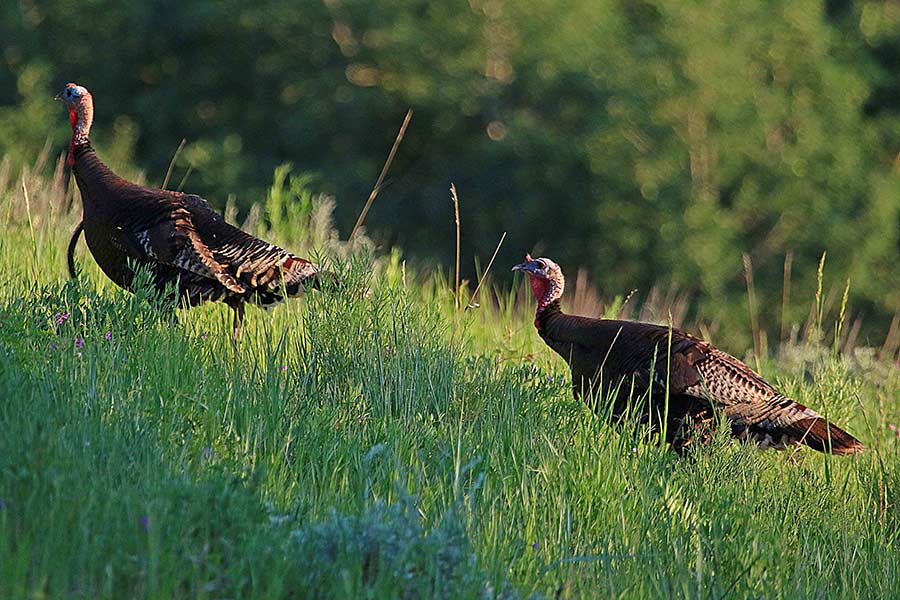What hunters should know about the 2021 Utah spring turkey hunts
Salt Lake City — Utah's spring general-season turkey hunts are about to get underway, and if you like the idea of harvesting your own delicious bird, it's not too late to buy a permit and research an area to hunt.
Utah's youth turkey hunt runs from April 30 to May 2, and the spring general-season turkey hunt runs from May 3–31. The limited-entry hunt began April 10 and will end April 29.
Here's what hunters should know about the upcoming general-season and youth hunts:
Utah turkey populations trending upward
There are two turkey subspecies that live in Utah: Rio Grande and Merriam's. There are currently between 25,000–35,000 wild turkeys throughout the state.
"Harsh winters are really hard on turkeys, so the mild winter we have had this year will have resulted in less winter kill," DWR Upland Game Coordinator Heather Talley said. "Other good news for hunters is that the mild winter also allows the turkeys to stay in public areas longer, and hopefully has kept them from moving into residential areas in search of food. The populations have been trending slightly upward in the last five years. If we don't get a lot of cold weather while the chicks are young this spring — and if there are enough habitat areas with water, flowering plants and insects available — I foresee a good production year for turkeys."
Where to hunt
Turkey populations in central Utah seem to be doing quite well, despite the drought last year. However, some birds in the area are in poor body condition. For hunters targeting central Utah, some good areas to find turkeys include Payson Canyon, Spanish Fork Canyon, the Grindstone Ridge area and benches around Utah Valley.
Turkey numbers seem to be a little lower in southern Utah this year. Hunters should look for birds in river corridor areas and their adjacent habitats.
"Locating cottonwood trees may help you find turkeys in the area," Talley said.
Turkey numbers in the northeastern region have decreased a little from previous years, most likely due to the severe drought conditions in Utah that have persisted over the past couple of years. Hunters should target the corridors along the Duchesne River, the Green River and the Ashley Creek drainage, which should all be good areas to hunt turkeys this year. Lower agricultural areas should also have good turkey hunting, but many of these areas are private property, so hunters will need to get written permission from landowners before hunting. There are also pockets of turkeys throughout much of the Book Cliffs and in the middle and lower areas of several major drainages across the northern and southern slopes of the Uinta Mountains.
In northern Utah, many turkeys can be found on private property around Morgan, Croydon, Huntsville, Eden and Mountain Green, but hunters must get written permission from the landowner to hunt on private properties. Turkeys can also be found on public land in Cache Valley, including Blacksmith Fork Canyon, the Richmond Wildlife Management Area (along Cherry Creek), the Wellsville Range above Wellsville and Mendon, and Walk-in Access areas around Clarkston. In Box Elder County, there are turkeys on the Raft River Mountains near Clear Creek, One Mile Creek, Johnson Creek and Wildcat Creek.
Turkey numbers should be better than last year in southeastern Utah. Hunters can find Merriam's turkeys in the La Sal and Abajo mountains. Popular areas to find Rio Grande turkeys in this part of the state include along the Colorado and Green rivers, as well as many of their tributaries such as the San Rafael River, Price River, Range Creek, Gordon Creek, Huntington Creek, Ferron Creek and drainages along the Book Cliffs. Be aware that many areas along these waterways are private land, and hunters must get written permission from the landowner before hunting.
"There is also an area along the Fremont River near Caineville that has an abundance of turkeys, many of which can be found in two Walk-in Access areas," Talley said.
General tips
Rio Grande turkeys are usually found at lower elevations. River bottoms dotted with cottonwood trees and areas containing mostly oak and pinyon-juniper trees are some of their favorite spots. Merriam's turkeys, on the other hand, are typically found in ponderosa pine forests at higher elevations.
If you're planning to hunt, try to get out and scout a few days before your hunt begins. Becoming familiar with the area and locating where the turkeys are is key to a successful hunt. You should spend time observing the turkeys' daily patterns so that during the hunt, you can set up in an area where the birds will be active. Typically, more turkeys are harvested between 10 a.m. and 2 p.m. than during any other time of day.
"Turkeys are often found on private property, so be aware of the land ownership in the area you're hunting and remember that you must get written permission from the landowner before you can hunt on their property," Talley said. "Also, calls and decoys can greatly increase your success, so take time to practice with those beforehand. And lastly, turkeys have incredible eyesight so be sure to wear good camo and sit very still."
For other general turkey hunting tips, visit the DWR website.
Buying a turkey permit
You can buy a permit for the statewide general season anytime between now and when the hunt ends on May 31. General-season permits are available on the DWR website or at a variety of license agent locations and DWR offices.
For more information on season dates and permits, check the 2020–21 Utah Upland Game & Turkey Guidebook. For information on legal weapon types, see page 23 in the guidebook, and note that rimfire firearms are not legal for the spring turkey seasons. The free guidebook is available on the DWR website or at hunting license agent locations and DWR offices.

















